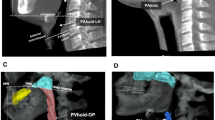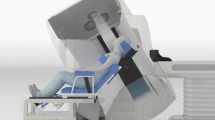Abstract
This study aimed to (1) evaluate changes in bolus and air volumes in the pharyngo-laryngeal cavity during swallowing and (2) determine how differences in these volumes during swallowing are influenced by bolus amount using 320-row area detector computed tomography (320-ADCT). Three-, 10-, and 20-ml honey-thick liquids (5% w/v) were presented to ten healthy subjects placed in a 45° reclining position. 3D images were created in 29 phases at an interval of 0.1 s for 3.15 s. Changes in bolus and air volumes in the pharyngo-laryngeal cavity were calculated. The two one-sided tests were used to determine equivalency of the pharyngo-laryngeal volume of each event (i.e., onset of hyoid elevation, soft palate closure, true vocal cord closure, closure of laryngeal vestibule, epiglottis inversion, pharyngo-esophageal sphincter opening) for each bolus volume. The pharyngo-laryngeal volume during swallowing was about 20 ml before swallowing. The volume temporarily increased with tongue loading, but decreased to about 0 ml with pharyngeal contraction. Subsequently, the volume returned to the original volume after airway opening. Most of the air was released from the pharyngo-laryngeal space before the bolus flowed into the esophagus during swallowing. As the bolus volume to be swallowed increased, the maximal pharyngo-laryngeal volume increased, but changes in air volume remained constant. 320-ADCT allowed for analysis of dynamic volume changes in the pharyngo-laryngeal cavity, which will increase our knowledge of kinematic and volumetric mechanisms during swallowing.




Similar content being viewed by others
References
Logemann JA, Pauloski BR, Rademaker AW, Colangelo LA, Kahrilas PJ, Smith CH. Temporal and biomechanical characteristics of oropharyngeal swallow in younger and older men. J Speech Lang Hear Res. 2000;43:1264–74.
Logemann JA, Pauloski BR, Rademaker AW, Kahrilas PJ. Oropharyngeal swallow in younger and older women: videofluoroscopic analysis. J Speech Lang Hear Res. 2002;45:434–45.
Ishida R, Palmer JB, Hiiemae KM. Hyoid motion during swallowing: factors affecting forward and upward displacement. Dysphagia. 2002;17:262–72.
Nakane A, Tohara H, Ouchi Y, Goto S, Uematsu H. Videofluoroscopic kinesiologic analysis of swallowing: defining a standard plane. J Med Dent Sci. 2006;53:7–15.
van der Kruis JG, Baijens LW, Speyer R, Zwijnenberg I. Biomechanical analysis of hyoid bone displacement in videofluoroscopy: a systematic review of intervention effects. Dysphagia. 2011;26:171–82.
Kahrilas PJ, Lin S, Chen J, Logemann JA. Oropharyngeal accommodation to swallow volume. Gastroenterology. 1996;111:297–306.
Ergun GA, Kahrilas PJ, Lin S, Logemann JA, Harig JM. Shape, volume, and content of the deglutitive pharyngeal chamber imaged by ultrafast computerized tomography. Gastroenterology. 1993;105:1396–403.
Kahrilas PJ, Lin S, Chen J, Logemann JA. Three-dimensional modeling of the oropharynx during swallowing. Radiology. 1995;194:575–9.
Kendall KA, Leonard RJ. Pharyngeal constriction in elderly dysphagic patients compared with young and elderly nondysphagic controls. Dysphagia. 2001;16:272–8.
Loenard R, Kendall KA, McKenzie S. Structural displacements affecting pharyngeal constriction in nondysphagic elderly and nonelderly adults. Dysphagia. 2004;19:133–41.
Fujii N, Inamoto Y, Saitoh E, Baba M, Okada S, Yoshioka S, Nakai T, Ida Y, Katada K, Palmer JB. Evaluation of swallowing using 320-detector-row multislice CT. Part I: single- and multiphase volume scanning for three-dimensional morphological and kinematic analysis. Dysphagia. 2011;26:99–107.
Inamoto Y, Fujii N, Saitoh E, Baba M, Okada S, Katada K, Ozeki Y, Kanamori D, Palmer JB. Evaluation of swallowing using 320-detector-row multislice CT. Part II: kinematic analysis of laryngeal closure during normal swallowing. Dysphagia. 2011;26:209–17.
Okada T, Aoyagi Y, Inamoto Y, Saitoh E, Kagaya H, Shibata S, Ota K, Ueda K. Dynamic change in hyoid muscle length associated with trajectory of hyoid bone during swallowing: analysis using 320-row area detector computed tomography. J Appl Physiol. 2013;15(115):1138–45.
Nakayama E, Kagaya H, Saitoh E, Inamoto Y, Hashimoto S, Fujii N, Katada K, Kanamori D, Tohara H, Ueda K. Changes in pyriform sinus morphology in the head rotated position as assessed by 320-row area detector CT. Dysphagia. 2013;28:199–204.
Inamoto Y, Saitoh E, Okada S, Kagaya H, Shibata S, Ota K, Baba M, Fujii N, Katada K, Wattanapan P, Palmer JB. The effect of bolus viscosity on laryngeal closure in swallowing: kinematic analysis using 320-row area detector CT. Dysphagia. 2013;28:33–42.
Inamoto Y, Saitoh E, Okada S, Kagaya H, Shibata S, Baba M, Onogi K, Hashimoto S, Katada K, Wattanapan P, Palmer JB. Anatomy of the larynx and pharynx: effects of age, gender and height revealed by multidetector computed tomography. J Oral Rehabil. 2015;42:670–7.
Kahrilas PJ, Logemann JA. Volume accommodation during swallowing. Dysphagia. 1993;8:259–65.
Brodsky MB, McFarland DH, Michel Y, Orr SB, Martin-Harris B. Significance of nonrespiratory airflow during swallowing. Dysphagia. 2012;27(2):178–84.
Acknowledgements
The authors sincerely thank the radiological technologists Mr. Y. Ida and Mr. M. Kobayashi for their invaluable assistance with the CT study. We also appreciate the valuable advice and suggestions provided by Dr. N. Fujii at the Department of Radiology, School of Medicine, Fujita Health University, and Dr. P. Wattanapan at the Institute of Medicine, Suranaree University of Technology.
Author information
Authors and Affiliations
Corresponding author
Ethics declarations
Conflict of interest
The authors declare no conflicts of interest.
Rights and permissions
About this article
Cite this article
Iida, T., Kagaya, H., Inamoto, Y. et al. Measurement of Pharyngo-laryngeal Volume During Swallowing Using 320-Row Area Detector Computed Tomography. Dysphagia 32, 749–758 (2017). https://doi.org/10.1007/s00455-017-9818-y
Received:
Accepted:
Published:
Issue Date:
DOI: https://doi.org/10.1007/s00455-017-9818-y




